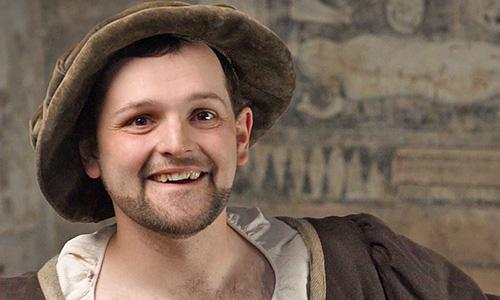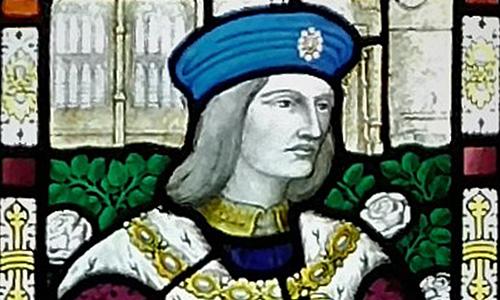A Fine Medieval View
While you are in Stratford-upon-Avon, try standing on the corner of Church Street and Scholars Lane, look across the road and you will catch a fine view of an impressive complex of surviving medieval timbered buildings. This is Stratford upon Avon’s Guildhall, described by historian, broadcaster and author Professor Michael Wood as:
“one of the most atmospheric, magical and important buildings in the whole of Britain.”
These buildings are still very much as they would have been even before William Shakespeare first saw them in the second half of the 1500s, decades after their completion. They both reflect and influence the history of the town over the last 600 years and, in one way or another, owe much to a trio of local medieval merchants and benefactors of the town who were all members of the town’s religious Guild of the Holy Cross and whose lives intertwined – Hugh Clopton, Thomas Jolyffe and Thomas Hannys.
The Guild Chapel and the Guildhall
To the far left of the buildings you will see the Guild Chapel, which was greatly extended in the late 1400s as a result of the legacies left in Hugh Clopton’s will. This is where the Guild held its public services of mass and where members would contemplate what lay in store for their souls after death.
Next to the Chapel is the Guildhall, completed in the 1420s. The Guildhall, along with the Guild Chapel, had great religious significance for Guild members, as well as being the social and administrative centre of the Guild and of the medieval town. Guildhalls were a type of medieval public building found across the cities, towns and villages of medieval England. Many disappeared during the sixteenth-century Reformation but Stratford’s Guildhall survived because of its connections to the town’s citizens and its school, which was also founded by the guild and re-founded in 1553 following the Reformation under its (continuing) title of King Edward VI Grammar School.
The Schoolhouse
Next to this you will see a small building which was once a schoolhouse (sometimes referred to erroneously as the ‘Infill House’). Although the guild probably had a school teaching grammar to (some) of the town’s boys from around 1296 onwards, this building was constructed in around 1427/8. It was endowed generously by Thomas Jolyffe in 1482. Most other boys would have been seeking apprenticeships and most girls would have been busy trying to learn domestic skills. Life for children was hard (and often short) and they had to enter adulthood very quickly.
The remainder of the buildings in this range are the Almshouses, built or extended at the very start of the 1500s probably on the site of earlier almshouse buildings, as a result of a bequest by another, Thomas Hannys, who had been apprenticed to and was the friend and executor of Hugh Clopton. Although the Guild is now long gone, these buildings still fulfil their basic original function as almshouses and now offer around twenty self-contained units supported by a warden. Being private residences, they are not open to the public.
In any event, the 1400s were obviously a time of great expansion for the Guild of the Holy Cross. The early 1200s had seen the growth of the town following the grant of its first market charter in 1196 by Richard I. In many towns, such as nearby Coventry, trades and industries formed crafts, or mysteries (sometimes called craft guilds), who protected the right to trade and inspected the qualities of goods. Some of the most famous crafts were the great Companies of London, such as the Mercers. Not all towns had such formal trading associations, however, and Stratford-upon-Avon was one of these. All towns, however, had religious guilds, or fraternities, whose function was to provide social, charitable and spiritual support for their members, especially by praying for their souls after death.
The Guild of the Holy Cross and the Clopton connection
Stratford’s Guild of the Holy Cross first appears in the records in 1269, but was probably an earlier foundation. It admitted male and female members who paid a ‘fine’ (from the French ‘fin’, essentially meaning to end or conclude the joining process) to join the Guild and annual subscriptions, including ‘lights’ money for candles on the altars in the parish church and Guildhall chapel. These fines were flexible. Some wealthy and high-ranking members were often admitted free of charge as they brought status and prestige to the guild and were expected to make significant contributions to guild funds in life or donations after their death. Poorer members were offered lesser fines, and some entry fees were met by the offer of goods/labour/services towards the Guild’s activities.
Although Hugh Clopton, the younger son of a local manorial family, spent much of his mercantile life in London and on the Continent, he never forgot his local roots and in 1469 (along with 24 fellow merchants from London) he followed the family tradition of joining the Guild. Why? Perhaps it was down to local family ties; perhaps he enjoyed being a big fish in a small pond; perhaps he wanted his London associates to join him in the annual feasts; perhaps he wanted those associates’ votes to help him become Guild Master for two years running, 1485-1487? Or, perhaps he was just very concerned about the fate of his soul after his death, especially as he had been accused of breaking various trading rules of the London mercers!
One of the highlights of Guild life was its annual guild feast, held in May. This was a lavish and sumptuous affair and was preceded by a grand and noisy parade around the town. Records of one such feast held in 1434, which Hugh’s parents may well have attended, describe the slaughter of 10 calves, 26 pigs, 200 chickens and 7 sheep, together with the inclusion of swans, ducks, geese and hundreds of gallons of beer and wine (including four gallons of wine just for breakfast the following day). Once the appetites of the Guild members had been well and truly met, leftovers were then given to the poor of the town – the Guild, in many respects, looked after its own members first before spreading its charity wider!
As a religious fraternity, the Guild also maintained up to six priests, who would offer regular masses in the Guild Chapel and pray for the souls of members. Being a Catholic, Hugh would have shared the belief that, on death, your soul could only make its eventual way to heaven after a potentially lengthy period of suffering and purification in Purgatory. Even the dead could be enrolled by their families to enjoy these post mortem benefits of Guild membership – paying only 50% of the initial ‘fine’, with no further annual subscriptions.
Hugh’s will of 1496 made specific bequests to the Guild priests but also to monastic communities across London and the Midlands for his soul and those of his parents.
‘Also I will that the prestes of...the yelde in Stratford-upon-Avon say and syng placebo and dirige with other orisons accustomed after Saesbury use, and masse of requiem by note, for my soule and the soules of my fader and moder every day during a month…’
The fifteenth-century Guildhall included parlours for the Holy Cross Guild priests and a private chapel which was decorated with religious imagery including a ‘reredos’ or painted backdrop to the altar featuring the image of the Throne of Mercy (God the Father supporting the crucified Christ, with the Holy Spirit in the form of a dove) flanked by the images of the Blessed Virgin Mary and St. John the Evangelist and St. John the Baptist. These images, like the Guild seal, refer to the close connections between the Holy Cross Guild and other guilds or devotional groups based in the parish church. Stencilled roses and crowned ‘M’ monograms cover the surfaces of the chapel walls, referring to the Virgin, accompanied by the IHS monogram or symbol, which is a contraction of the Greek word for Jesus.
The Reformation and Shakespeare’s Schoolroom
Everything changed for the Guild in 1547 when, as part of the English Reformation, all guilds, chantries and colleges were dissolved and their assets seized by the Crown. Prayers and masses for the dead were banned - and the idea of Purgatory was abolished. Stratford’s community petitioned hard for a charter of incorporation for a new Borough Council, which was finally granted in 1553, by Henry VIII’s son, Edward VI. The school was re-founded and re-named in his honour and the Borough Council took over the guild buildings, drawing on their rich associations, including their connections with the memory and legacies of Hugh Clopton, Thomas Jolyffe and Thomas Hannys.
To find out how the building was adapted to become the headquarters of the Council, and how the schoolroom moved from Church Street into the Guildhall, where Shakespeare was educated and inspired, do come and visit us, or go online to discover more:
Further reading
- Robert Bearman (1997) The History of an English Borough Stratford-upon-Avon 1196-1996 (Stroud (Gloucs): Sutton Publishing)
- Kate Giles, Anthony Masinton and Geoff Arnott (2012) ‘Visualising the Guild Chapel, Stratford upon Avon’, Internet Archaeology 32: https://intarch.ac.uk/journal/issue32/1/toc.html
- Kate Giles, 2017 ‘Digital Creativity and the Wall Paintings of 'Shakespeare's Guildhall', Stratford-upon-Avon’, Internet Archaeology 44: https://intarch.ac.uk/journal/issue44/6/index.html
- Mairi Macdonald (2007) The Register of the Guild of the Holy Cross, St. Mary and St. John the Baptist, Stratford-upon-Avon (Dugdale Society no. 42)
- Ronnie Mulryne (ed.) (2013) The Guild and Guild Buildings of Shakespeare’s Stratford-upon-Avon (Farnham: Ashgate)
- Ronnie Mulryne, Andrew Burnet and Margaret Shewring (2016) Shakespeare’s Schoolroom and Guildhall (Peterborough: Jarrold Publishing)
Other local buildings our volunteers suggest you visit:












